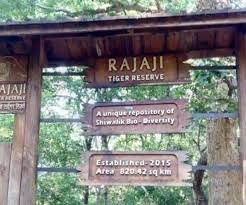28 Sep 2021 Rajaji Tiger Reserve

- Recently, a Supreme Court-appointed committee has questioned relaxations given for the upgrade of a 4.7-km road (Laldhang-Chillarkhal road) in the buffer zone of Rajaji Tiger Reserve and sought replies from the Centre and Uttarakhand government.
- The relaxation for measurement of roads was approved by the National Board for Wildlife(NBWL). NBWL is the apex agency to clear projects in and around protected areas.
Important Points
Core and Buffer Area of a Tiger Reserve:
-
According to the Wild Life (Protection) Amendment Act of 2006, a tiger reserve must have a core or critical habitat and a buffer zone peripheral to it.
-
While the critical habitat is supposed to be kept inviolate for conservation, a buffer zone is needed to ensure the integrity of the habitat with adequate space for dispersal of tigers. It is aimed at promoting coexistence between wildlife and human activity.
About Rajaji Tiger Reserve:
Location: Haridwar (Uttarakhand), along the foothills of the Shivalik range. It is part of Rajaji National Park.Background: Rajaji National Park was established in the year 1983 after amalgamating three sanctuaries in the Uttarakhand i.e. Rajaji, Motichur and Chila.
- It was named after the famous freedom fighter C. Rajgopalachari; popularly known as “Rajaji”.
- It was declared a Tiger Reserve in 2015 as the 48th tiger reserve of the country.
- Salient Features:
- Flora: Broadleaved deciduous forests, riverine vegetation, scrubland, grasslands and pine forests form the range of flora in this park.
Sal (Shorea robusta) is the characteristic dominant tree species. - Fauna: The reserve is home to more than 50 species of mammals including tiger, elephant, leopard, Himalayan black bear, sloth bear, jackal, hyena, spotted deer, sambhar, barking deer, nilgai, monkeys and over 300 species of birds.
- Rivers: The Ganga and Song rivers flow through this.
- Other Protected Areas in Uttarakhand:
- Jim Corbett National Park (first National Park of India).
- Valley of Flowers National Park and Nanda Devi National Park which together are a UNESCO World Heritage Sites
- Govind Pashu Vihar National Park and Sanctuary.
- Gangotri National Park
- Nandhaur Wildlife Sanctuary.
-
Source- Indian Express
-


No Comments